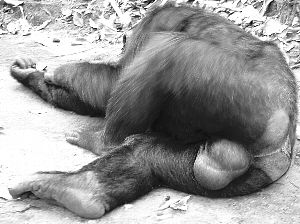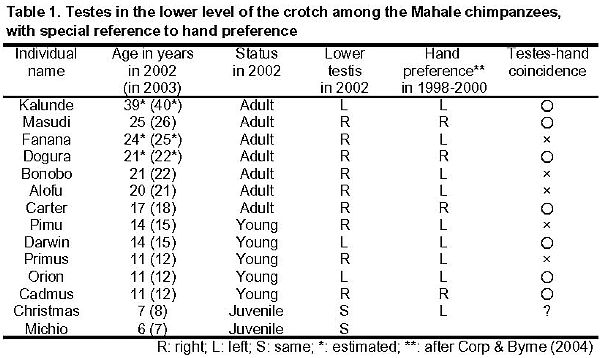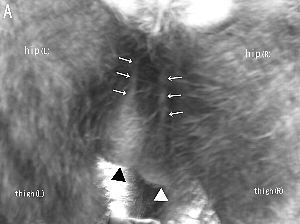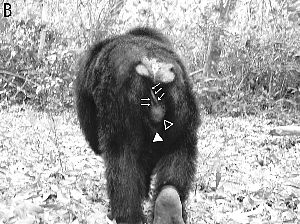|
Position and movement of the testes of wild chimpanzees at Mahale
Nakai Masashi and Zamma Koichiro Kyoto University  Figure 1. Masudi, a 25-year-old male, in 2002. Note his huge scrotum. The huge scrotum is one of the most conspicuous features of mature male chimpanzees (Figure 1). In humans, the left testis is hanging lower than the right in 57-80% of cases (1). To the best of our knowledge, however, no such report on chimpanzees has been published, even though their testes are the biggest and heaviest among primates (2).
From September to November, 2002, the first author spent seven weeks in the Mahale Mountains National Park (MMNP), Tanzania. It was his first experience to try to identify wild chimpanzees (Pan troglodytes schweinfurthii) in the field. He pursued male chimpanzees of M group with the help of a research assistant. While pursuing them, the huge hanging scrotum of adult males struck him as a great hindrance to walking.
A few weeks passed. Gradually he noticed that every scrotum had individual characteristics and that he could even identify several individuals by their scrotums. For example, the flabbiest scrotum with a greatly dangling left testis belonged to the oldest male, Kalunde; the hairiest scrotum with a fairly dangling right testis indicated Bonobo (Figure 2) in his early twenties; a dark-spotted scrotum with a mildly dangling left testis indicated Darwin in his middle teens. Then he began to recheck all males for both the shape of the scrotum and the movement of the testes. Table 1 shows which testis was lower in each individual. The scrotums of the two juveniles were undeveloped and still small; the left and right testes were located at the same horizontal level in their crotch. Among twelve mature males, seven full adults and five young adults, no individual showed fair symmetry in the position of his testes. It is reasonable that the testes of a sexually mature male should be alternatively situated in his crotch. If both of big testes were located at the same level, he might experience difficulty walking due to the maximized width of his scrotum. After returning to Japan, the first author asked the last author to observe the testes of the Mahale chimpanzees during his research in MMNP in 2003, to examine whether any secular change or inter-observer error can be detected. The last author was asked to record the location of the testes when the chimpanzee is standing and walking. To keep his observations unbiased, he was not disclosed the details of the first author's observations until he finished his work. In the beginning of August, 2003, the last author departed for Mahale and came back to Japan in the middle of December, 2003. Then he gave to the first author a sequential list of the records taken during August and September. His results were compared with those of the first author and a beautiful similarity between them was found. No secular change has happened, at least not within the last year; the positional difference between the testes in mature males is so evident that little inter-observer error can be found.
The main points revealed by our investigations can be summarized as follows:
Next we propose that the shape of the scrotum, including the asymmetric position of the testes, can be used as a new trait in the individual identification for mature male chimpanzees. Such a noteworthy trait has at least two advantages. It can easily be checked from behind an individual as seen in Figure 2. This manner may be especially helpful when one is tracking a target. This trait also has a discrete nature, just right or left, that is easy to remember. Among the twelve mature male chimpanzees of M group, nine have a right dangling testis, and three have a left dangling testis, respectively (Table 1). This ratio seems contrary to the ratio seen in humans (1). However, the number of individuals examined in our investigations is too small to derive any conclusions now. At least four possibilities might explain why the matured testes are asymmetrical: 1) the asymmetrical distribution of internal organs; 2) the asymmetrical morphology and function of the brain; 3) hand preference; and 4) foot preference. The data on the hand preference of Mahale chimpanzees has already published (3). No relationship can be recognized between the testes and the hands (Table 1). Further studies are needed to learn the cause of the asymmetry of the testes.
Back to Contents |


